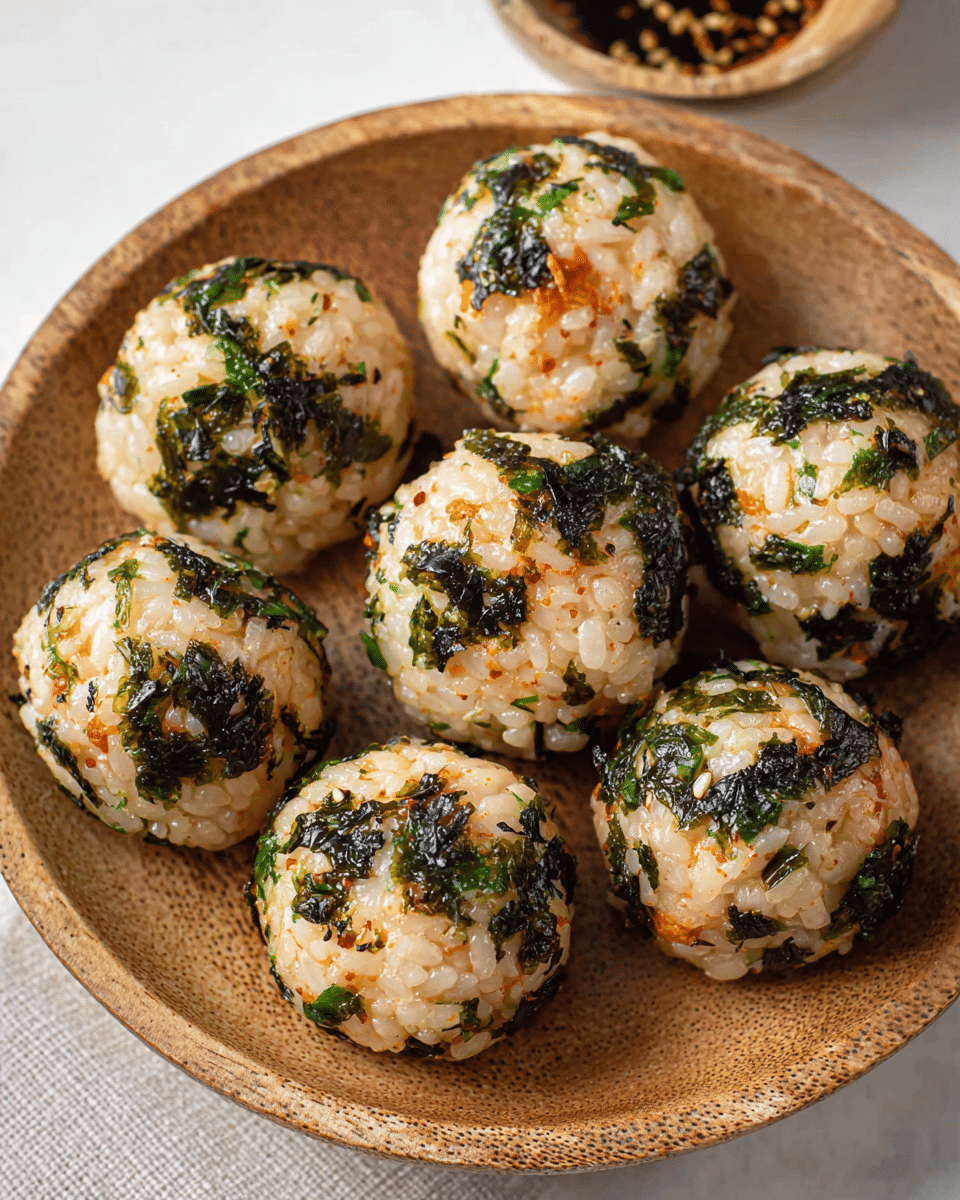Korean Rice Balls, also known as Jumeokbap, are a flavorful and convenient snack that brings the perfect balance of spicy, savory, and umami flavors. These rice balls are filled with the richness of sesame oil, the kick of gochujang, and the tang of kimchi, making them a unique fusion of taste in every bite.
The simplicity of the ingredients makes this dish incredibly versatile. You can adjust the level of spice to your liking by adding more or less gochujang, or you can make them vegan by omitting the kimchi or using a vegan alternative. Whether you’re snacking on the go or serving them as part of a larger meal, these Korean Rice Balls are guaranteed to be a crowd-pleaser.
Full recipe:
Ingredients:
-
2 cups cooked short-grain rice
-
1 tablespoon sesame oil
-
1 tablespoon soy sauce
-
1 tablespoon gochujang (Korean chili paste)
-
1/4 cup chopped kimchi
-
1 tablespoon sesame seeds
-
2 tablespoons roasted seaweed flakes
-
1 teaspoon garlic powder
-
1 tablespoon chopped green onions
-
Salt to taste
Directions:
-
In a bowl, combine the cooked rice, sesame oil, soy sauce, gochujang, and garlic powder. Mix well until the rice is evenly coated with the seasoning.
-
Stir in the chopped kimchi, sesame seeds, roasted seaweed flakes, and green onions. Mix thoroughly.
-
Using your hands, form the rice mixture into small, bite-sized balls (about the size of a golf ball).
-
Sprinkle a little more sesame seeds or roasted seaweed flakes on top for garnish, if desired.
-
Serve immediately or pack them as a snack for later.
Prep Time: 10 minutes | Cooking Time: 5 minutes | Total Time: 15 minutes Kcal: 180 kcal per serving | Servings: 4 servings
Origin and Significance of Jumeokbap
Jumeokbap has its roots in traditional Korean home-cooked meals. Historically, rice has been a staple in Korean cuisine, and Jumeokbap offers a portable and easy-to-eat option for those on the go. Korean rice balls are not only a great snack for children, but they are also commonly enjoyed by adults, especially when they need a quick, satisfying meal during work or travel. They are often served in Korean households and are found in Korean convenience stores and restaurants as a popular item for those seeking a simple and hearty bite.
The dish offers versatility, as it can be enjoyed plain, or with a variety of fillings, such as kimchi, seasoned tofu, or ground meat, allowing for countless adaptations based on one’s dietary preferences or what ingredients are available. It is often seen as a practical meal solution for busy families, as the rice balls can be prepared in advance and consumed at any time, making it an ideal snack or lunchbox option.
Ingredients Used in Korean Rice Balls (Jumeokbap)
The primary ingredients in Jumeokbap are short-grain rice, canned tuna, Japanese mayonnaise, sesame oil, and seasoned seaweed flakes. However, this dish can be easily modified to suit various dietary restrictions. For instance, while canned tuna is the traditional protein used, you can swap it for scrambled eggs, cooked salmon, seasoned tofu, or even ground chicken or beef. The addition of toasted sesame seeds further enhances the flavor, while the seaweed flakes provide a crisp, umami-packed exterior.
The rice used in this dish is typically short-grain rice, which is sticky enough to hold the rice balls together. Long-grain rice would not work as well because it does not have the same level of stickiness that is crucial for shaping the rice into balls. If you’re using leftover rice, you can simply reheat it to ensure the texture is appropriate for making the rice balls. For the best results, it’s recommended to use warm rice as it helps the rice mixture bind together more effectively when forming the balls.
How to Make Jumeokbap
To prepare Jumeokbap, you first start by heating up your rice if you’re using leftover rice. It’s important that the rice is warm, as this allows the rice balls to maintain their shape. Then, mix the rice with tuna, sesame oil, mayonnaise, and sesame seeds. The combination of these ingredients gives the rice a creamy, rich texture while also infusing it with a savory, nutty flavor. After the mixture is well combined, you can start forming the rice balls. Wet your hands before rolling the rice into balls to prevent sticking, and roll them into bite-sized portions.
Once the rice balls are formed, coat them in seasoned seaweed flakes, which are sold in most Korean grocery stores. This adds a delightful crunch and additional layers of flavor to the dish. If you don’t have seasoned seaweed flakes, you can substitute with crushed nori sheets or furikake, a Japanese seasoning made with seaweed and sesame seeds. The finished rice balls can be eaten immediately or stored for later.
Storage and Shelf Life
While Jumeokbap is best eaten the same day, you can store any leftovers in an airtight container in the refrigerator. They can stay fresh for up to two days. However, it is important to note that once refrigerated, the rice balls may begin to lose some of their texture, and the seaweed may become soggy. Reheating the rice balls in the microwave is possible, but doing so might enhance the fishy flavor due to the tuna and seaweed. If you prefer to enjoy them at room temperature, simply let them sit out for a while before serving.
Pairing Suggestions
Jumeokbap can be served as a standalone snack, but it also pairs well with various Korean side dishes. Some great accompaniments include Korean cucumber salad, bean sprout salad, zucchini fritters, or Korean spinach. Additionally, Japchae, a savory Korean stir-fried noodle dish, makes for an excellent pairing to balance out the richness of the rice balls. If you’re looking for a light, refreshing addition to the meal, consider serving it with a side of Kimchi for an extra burst of flavor.
Frequently Asked Questions about Jumeokbap
-
What type of tuna should I use?
For the best results, use canned tuna in oil, but canned tuna in water can also be used if preferred. The tuna adds protein to the rice balls and is easy to incorporate into the recipe. -
Can I make Jumeokbap without tuna?
Yes! You can replace the tuna with scrambled eggs, seasoned tofu, chopped kimchi, or even cooked meat such as ground pork or chicken. This makes Jumeokbap highly customizable based on your dietary preferences. -
How do I store the rice balls?
Store leftover Jumeokbap in an airtight container in the refrigerator. The rice balls are best enjoyed within two days for maximum freshness.
Why You Should Try Jumeokbap
Jumeokbap is a fantastic option for anyone looking for a quick and flavorful meal. With its simple ingredients and minimal preparation time, it is a great choice for busy individuals or families. The combination of warm rice, tuna, and creamy mayonnaise makes each bite incredibly satisfying, while the seasoned seaweed adds an extra layer of texture and taste. Whether you’re looking for a light snack or a fulfilling lunch, Jumeokbap is sure to please your taste buds.
Additionally, this dish offers endless opportunities for experimentation. Feel free to customize the ingredients to suit your tastes. You can add spicy gochujang (Korean chili paste) for a kick or swap out the tuna for a vegetarian option. No matter how you make it, Jumeokbap is a versatile and delicious option for anyone looking to try Korean cuisine in an easy and accessible way.
Conclusion
Korean Rice Balls (Jumeokbap) are a perfect example of how simplicity can lead to an incredibly flavorful and satisfying dish. This recipe is a great way to enjoy the authentic tastes of Korean cuisine in the comfort of your own home. With just a few simple ingredients, you can create a delicious and customizable snack that’s perfect for any occasion. Whether you’re looking for a quick meal, a picnic snack, or a lunchbox option, Jumeokbap is a must-try.






